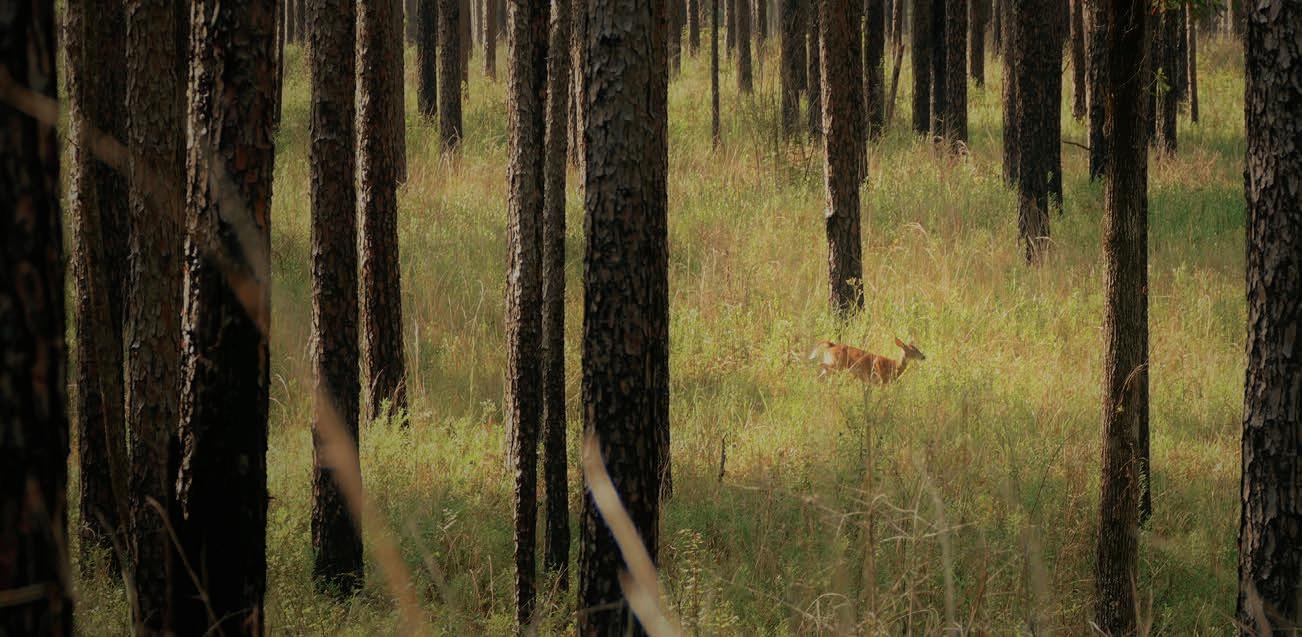
2 minute read
Window into Wildlife

WINDOW WILDLIFE into
Advertisement


White-tailed Deer
(Odocoileus virginianus)
Photo by Jay McClain at the Chickasawhay Ranger District, National Forests in Mississippi
Description

White-tailed deer are native North American ungulates, i.e., mammals with hooves, and the most popular big game species in the U.S. Their coats can range in coloration from reddishbrown to gray-brown depending on the time of year, and young fawns have white spots that fade as they mature. Male deer, or bucks, have antlers that grow and shed yearly. A buck’s antler size is influenced by age, nutrition, and genetics.
Distribution & Habitat
White-tailed deer are found throughout the longleaf pine range, and populations are stable across the southern U.S. They are a generalist species that utilize a variety of habitats that provide suitable food, cover, water, and space. Bucks generally have larger home ranges than does, and their movements are most wide-ranging during the rut or breeding season. Two common predators of white-tailed deer in the southern U.S. are coyotes and bobcats.
Diet
As herbivores, white-tailed deer browse a variety of plants, including forbs, shrubs, fruits, and hard mast (nuts and oneseeded fruits). Acorns are an important seasonal component of a deer’s diet in the fall and winter; however, forbs like pokeweed and ragweed comprise the majority of a deer’s diet during the spring and summer. Fruits like blackberry are also commonly consumed.
Deer in Longleaf
The native groundcover found in longleaf pine ecosystems contains some of the white-tailed deer’s favorite foods and essential cover. Native warm-season grasses like broomstraw provide excellent cover for fawns as well as areas for bucks and does to bed down. Beautyberry, which can be promoted through periodic prescribed burning, is high in protein and an important source of soft mast (berries and fruits) in the fall. Ragweed, often thought of as quail brood-rearing cover, is also high in crude protein and selected by deer as forage.
Managing longleaf pine stands for relatively open canopies that allow sunlight to reach the forest floor increases the food and cover available to deer in the understory. Prescribed fire, particularly when utilized in a sequential patch burning style, can be a beneficial management tool by creating habitat diversity for deer and other wildlife. Additionally, prescribed burning releases the nutrients in dead plant material back into newly growing vegetation for deer to consume.
Fun Facts
l White-tailed deer have dichromatic vision and only see in the blue and yellow color spectrums. l Twin fawns can have different fathers. l If you see a fawn alone in the woods, leave it there. Its mom is probably nearby and will be returning shortly!
References
Miller, J.H., & Miller, K.V. (2005). Forest Plants of the Southeast and their Wildlife Uses. Athens, GA: The
University of Georgia Press. Harper, C.A. (2016). A Guide to Wildlife Food Plots and Early
Successional Plants. Knoxville, TN: University of Tennessee Institute of Agriculture. Yarrow, G.K. & Yarrow, D.T. Yarrow. (1999). Managing
Wildlife. Birmingham, AL: Alabama Wildlife Federation. Innes, Robin J. (2013). Odocoileus virginianus. In: Fire
Effects Information System, [Online]. U.S.
Department of Agriculture, Forest Service, Rocky
Mountain Research Station, Fire Sciences Laboratory (Producer). www.fs.fed.us/database/feis/animals/ mammal/odvi/all.html.











